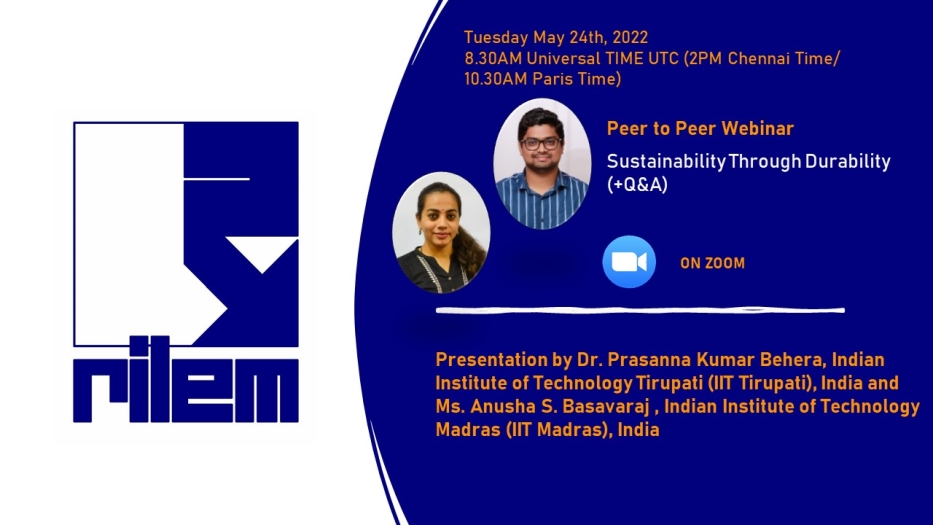Events calendar

RYC Peer-to-Peer webinar: Sustainability Through Durability
The first Peer-to-Peer webinar will take place on Tuesday May 24th, 2022 at 8.30AM UTC, (2PM Chennai Time/ 10.30AM Paris Time) and will be one hour long (2*20 minutes presentations + 10-minute interaction). The registration for this webinar is free.
Theme of the Peer-to-Peer Webinar: Sustainability Through Durability
REGISTER FOR FREE HERE.
Speaker 1: Dr. Prasanna Kumar Behera
Title: Obtaining an accurate estimate of service life in concrete structures: A step towards ensuring Sustainability.
Premature deterioration and reduction in the life of reinforced concrete (RC) structures due to corrosion of embedded reinforcing steel bars is a major concern across the world. Deterioration processes, like carbonation and chloride-attack leading to rebar corrosion, have been extensively studied, and it is worth mentioning that rate of corrosion of rebar in a concrete environment plays a major role in estimating service life of an RC structure as it affects the time-to-cover cracking.
Formation of longitudinal cracks due to rust formation at the steel-concrete interface and the rate of crack growth, which forms the basis of estimating service life, are not only affected by the properties of concrete, but also by the properties of steel. And in this context, it is important to consider that rebar inside concrete is subjected to stresses and strains. Presence of strain in rebar could affect the rate of corrosion, and hence, ignoring their presence in rebar could lead to an over-estimation of service life. Furthermore, corrosion could aggravate near the bends and hooks, which are inevitable for stirrups and bent bars, as they are subjected to huge plastic deformation, whose impact on the rate of corrosion is far from fully understood.
The seminar discusses the research work carried out to understand the rate of corrosion of plastically deformed steel bars in corrosive environments like chloride-rich electrolytes and chloride-contaminated mortar. The talk presents the effect of pre-strain on the mass-loss of rebar required to cause cracking in chloride-contaminated mortar by characterizing the rust formed at the steel-mortar interface. Based on the corrosion kinetics and corrosion amount at the interface, effect of pre-strain on time-to-cover cracking (Tcr), and also the probable approaches to mitigate corrosion near bends, will be presented.
Speaker 2: Ms. Anusha S. Basavaraj
Title: Assessment of Sustainability Parameters for Concrete Systems with Blended Binders
Concrete made with Ordinary Portland Cement (OPC) is the most abundantly used construction material in the world. Due to the huge volumes, the concrete industry, particularly the cement sector, has a very high environmental impact in terms of greenhouse gas (GHG) emissions, energy requirement and consumption of natural resources. Consequentially, any reduction in the emissions by suitable alternative technologies would make a significant impact on the global scenario. The most viable alternative is the judicious use of industrial by-products or residues with low embodied impacts, as supplementary cementations materials (SCMs). Fly ash, slag and limestone - calcined clay are the most promising SCMs that can substitute Portland clinker. In general, SCMs can improve long-term strength and significantly enhance durability characteristics of concrete. Another viable approach to improve the sustainability in concrete construction is to provide the desired durability in the beginning. This in-turn can avoid the usage of material, energy and expenditure to address premature repair needs during the expected service life and decreases the total life cycle impacts. For concrete sustainability, adequate mechanical and durability performance is essential, along with low environmental impact.
This work explicitly aims at developing a methodology to choose concrete based on sustainability parameters defined for concrete. A framework is proposed to facilitate the identification of sustainable concretes from the multitude of choices that could be available for a construction project. For this framework, a new set of indicator, called apathy index (A-index, in short), is proposed based on carbon footprint and durability parameters governing the service life of concrete systems. It is proposed that the decision-making for sustainable concrete should be based on the minimization of the A-index and the energy intensity index, which is the energy demand per unit strength.
For the representation of the environmental impacts, the present work considers life cycle approach. The environmental impacts in terms of carbon footprint and embodied energy were obtained for a set of concretes with different binder combinations for which durability and mechanical parameters were also determined. The use of SCMs reduces the embodied impacts, with the increased performance of the concrete system making it more sustainable. The outcome of this work could help cement manufacturers, other stakeholders and policymakers to promote carbon-friendly cement/concrete production, and further track the progress towards low emissions targets set by the government and to accomplish Sustainability Development Goals (SDGs).
No comment
Log in to post comment. Log in.





